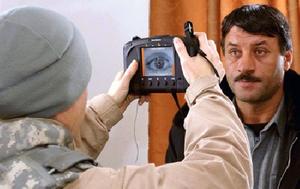Law-enforcement technologyMobile biometric device expedites identity matching
The Stockton (California) Police Department (SPD) has been quietly testing a state-of-the-art Mobile Biometric Device (MBD) technology for the past four years. Designed quickly to scan fingerprints, irises, and other biological information while officers and evidence technicians are on the field, MBDs can communicate with remote fingerprint databases and confirm matches in as little as three minutes.

Mobile biometric device being used in demonstration // Source: vbio.ru
The Stockton (California) Police Department (SPD) has been quietly testing a state-of-the-art Mobile Biometric Device (MBD) technology for the past four years. Designed quickly to scan fingerprints, irises, and other biological information while officers and evidence technicians are on the field, MBDs can communicate with remote fingerprint databases and confirm matches in as little as three minutes. In partnership with DHS’s Science and Technology Directorate (S&T), Sandia National Laboratories took the lead on testing and evaluating the technology in July 2010. Today, sixty-two law enforcement jurisdictions are testing MBDs, with some specializing in the device’s iris and facial recognition capabilities. SPD has played a significant role in perfecting MBDs’ fingerprint function.
“This is an example of the Stockton Police Department being involved in a partnership that allows us to use some of the best cutting-edge technology out there, and this is something that really helps us with investigative leads in near-immediate time,” Stockton Police Chief Eric Jones said. “Part of our vision here at the Stockton Police Department is to always look for technology that can help us better combat crime.”
MBDs are about four inches wide and ten inches long, weighing about three pounds. They offer a quicker and mobile alternative to traditional fingerprint matching methods. “With the traditional method, you would have to dust the print, lift it with lifting tape, take it back to the office and process the image on a digital flatbed scanner,” said Erin Mettler, SPD’s fiscal planning and research manager. “From that capture, the latent print examiner then looks at the ridge detail and dissects the fingerprint trying to find minutiae points, and then runs the fingerprint through the database to try to find potential matches. It could take a day. It could be a week later, depending on the type of crime.”
TheRecord notes that for law enforcement in Stockton, MBDs are particularly useful in commercial, residential, and auto burglaries, but the technology does have limitations. MBDs rely on the quality of fingerprint images to generate potential matches. Poor lighting and curve surfaces can affect the quality of an image. “When you scan a print on the flatbed scanner, the print examiner is plotting points on the print,” Mettler said. “When you identify the unique characteristics, you have a better potential for a match in the database. This device doesn’t do that. You’re relying strictly on the algorithm within the device that is digitizing the image.”
While MBDs are unlikely to soon replace traditional fingerprint matching methods, the devices will become common in evidence technicians’ tool boxes. “The more information we have on a crime scene, the better off we’re going to be,” Mettler said. Adding that “the potential matches we get as a result of using this device allow an investigator to identify persons of interest that they want to talk to. If there are no witnesses and no leads, this device could potentially provide that lead.”
